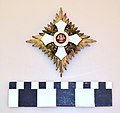Order of Civil Merit (Bulgaria)
You can help expand this article with text translated from the corresponding article in German. (January 2019) Click [show] for important translation instructions.
|
| Royal Order of Civil Merit Орден за гражданска заслуга | |
|---|---|
House of Saxe-Coburg-Gotha-Koháry | |
| Religious affiliation | Bulgarian Orthodox |
| Ribbon | White with a Green Stripe on either side and a Red Stripe on either Edge (Colours of the Flag of Bulgaria) |
| Eligibility | Bulgarian and foreign citizens |
| Awarded for | Awarded with the personal benevolence of the monarch |
| Status | Unconstituted |
| Grand Master[1] | King Simeon II |
| Grades | Knight/Dame Grand Cross Knight/Dame Grand Officer Knight/Dame Commander Knight/Dame Officer Knight/Dame Medal |
| Precedence | |
| Next (higher) | Royal Order of Bravery |
| Next (lower) | Royal Order of National Labour |
| Equivalent | Royal Order of Military Merit |
The ribbon of the Order | |
The Order of Civil Merit was an Order of Merit of the Kingdom of Bulgaria. Established in 1891, it had six classes.
History
The Bulgarian Order of Cvil Merit was established on either 2 or 14 August 1891 by then Prince Ferdinand, and was founded with six classes and a Grand Cross grade. The order lasted until formerly dissolved by the Communist government of Bulgaria in 1946. The order has been revived by the current Republic of Bulgaria and is awarded today.
Grades of the Order

- Grand Cross
- I Class – Great Cross
- II Class – Grand Officers cross
- III Class – Commanders cross
- IV Class – Officers cross
- V Class – Knights cross
- VI Class – Silver Cross
Insignia and design
The Orders design was made up of a white-enamelled
Recipients
- Arthur Zimmerman (1912)
- Pierce Charles de Lacy O'Mahony (1915)
- Kurt Klaudy (1938)
- Herman Senkowsky (1941)
- August Beckman
- Konrad zu Hohenlohe-Schillingsfürst [2]
- Johann Strauss (son)
- Viktor Urbanchich
- Ferdinand I of Bulgaria
- Boris III of Bulgaria
- Simeon II of Bulgaria
| Order of Civil Merit Орден за гражданска заслуга | |
|---|---|
State Order | |
| Religious affiliation | Bulgarian Orthodox |
| Ribbon | White with a Green Stripe on either side and a Red Stripe on either Edge (Colours of the Flag of Bulgaria) |
| Eligibility | Bulgarian citizens. |
| Awarded for | Awarded for great merit to the development and consolidation of the civil society. |
| Status | Currently awarded |
| Grand Master | President Rumen Radev |
| Grades | Commander Officer |
| Precedence | |
| Next (higher) | Order of Saints Cyril and Methodius |
| Next (lower) | Order of the Madara Horseman |
| Equivalent | Order of Military Merit |
The ribbon of the Order | |
Gallery
-
Order of Civil Merit in diamonds for ladies (Bulgaria before 1946) - Tallinn Museum of Orders
-
Order of Civil Merit Dame 5th Class for ladies (1946)
-
Bestowal document for the Order from the reign of Boris III.
-
Knight 5th Class of the order.
-
Officer 4th Class of the Order.
-
Order of Civil Merit Grand Cross badge and sash (Bulgaria before 1946) - Tallinn Museum of Orders
-
Grand Officer star.
-
Grand Officer case.
-
Grand Officer badge.
-
Set of the Grand Cross grade of the order (post 1908).
-
Commander reverse (1908-1944).
-
Commander (1908-1944).
-
Commander reverse badge (1908-1944).
-
Commander obverse badge (1908-1944).
-
Commander grade and case from the reign of Boris III.
-
Commanders class of the Princely version of the order (1908-1946).
-
Commanders class of the Princely version of the order (1908-1946).
-
Commanders class of the Princely version of the order (1908-1946).
-
Commanders class of the Princely version of the order (1908-1946) by Johann Schwerdtner of Vienna.
-
The "Princely Crown" of Bulgaria used as the suspension on models of the order from 1891-1908.
-
Close-up of the obverse of the cross showing Ferdinand I's monogram.
-
Close-up of the reverse of the badge of the Commanders Class showing the un-enamelled oak leaves on some sets of insignia.
-
Commanders class of the Princely version of the order (1908-1946).
-
Commanders class of the Princely version of the order (1908-1946).
-
Case for the Commanders Class, bearing the Royal Arms of the Kingdom of Bulgaria c.1895
The Republic Order
The Order was revived by the current Republic of Bulgaria. However today it is only awarded to Bulgarian citizens. In addition the Order now is only made up of the Officer and Commander grades, and the reverse and obverse of the modern order are switched around. What was the reverse on the Kingdom order is now the obverse and depicts the Bulgarian lion, however without the Saxon shield. The new reverse no longer depicts the royal monogram of Ferdinand I, and instead a rotated tricolour of the Bulgarian flag. While the exact shading has differed dramatically, the ribbon has remained mostly unchanged, interestingly as has also the crown suspension.
References
- ^ The Grand Master of the Bulgarian Orders - official website of H.M. Simeon II
- ^ "ÖNB-ALEX - Staatshandbuch". alex.onb.ac.at. Retrieved 23 January 2023.
























